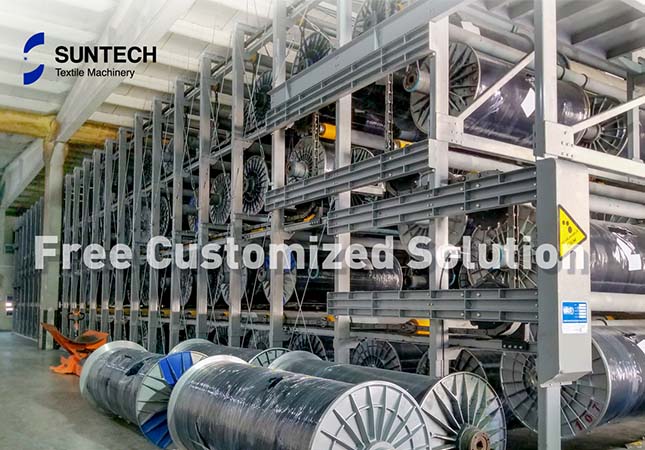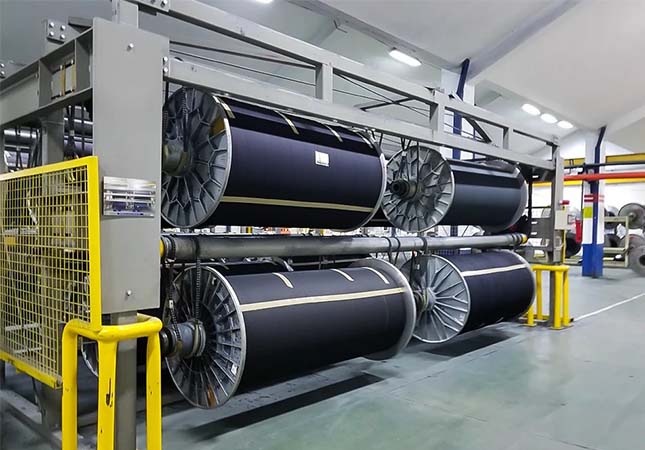Beam storage is a vital component of the textile industry's manufacturing process, and its evolution can be traced back to the early days of textile production. Beam storage has also become more and more sophisticated to meet the needs of the ever-improving factories.

The History of Beam Storage
Over the centuries, the storage and handling of beams have undergone significant changes, reflecting the advancements in technology and the increasing demand for efficiency and productivity.
In the early days of the textile industry, the storage of beams was a relatively straightforward process. Weavers would wind the finished fabric onto wooden beams, which were then stored vertically in racks. The beams were often marked with the name of the weaver or the pattern of the fabric, making it easy to identify them later. This system worked well for small-scale operations, but as the industry grew, more efficient storage methods became necessary.
l One of the first advancements in beam storage came with the invention of the Jacquard loom in the early 19th century. This loom used punch cards to control the weaving process, allowing for more intricate designs to be created. However, the punch cards added an extra step to the weaving process, and storing them alongside the beams became a challenge. To address this issue, a system was developed in which the punch cards were stored separately in drawers, and the corresponding beams were marked with the drawer number. This made it easier to find the correct punch cards when setting up the loom.
l As the textile industry continued to grow, so did the need for more efficient beam storage solutions. In the mid-19th century, a new system was developed that allowed for beams to be stored horizontally, one on top of the other. This was made possible by the invention of the beam stacker, the machine that could lift and stack beams on top of each other. The beam stacker made it possible to store a large number of beams in a small space, and it became a standard piece of equipment in textile mills.
l Over the years, the beam stacker underwent numerous improvements and became more sophisticated. In the early 20th century, the first automatic beam stackers were developed, which could lift and stack beams without any manual intervention. This allowed for even greater efficiency and productivity in the textile industry.
l In the 1950s, the advent of synthetic fibers such as polyester and nylon created new challenges for beam storage. Unlike natural fibers, which could be stored for extended periods without losing their properties, synthetic fibers tended to break down over time. This made it necessary to store synthetic fiber beams in a controlled environment with low humidity and temperature. To address this issue, specialized beam storage facilities were developed, equipped with air conditioning and dehumidifiers.
l Another major advancement in beam storage came with the development of the computerized weaving machine in the 1980s. These machines could store thousands of patterns and automatically select the correct beam for each job. This made it possible to weave a wide range of fabrics with greater efficiency and accuracy.
l Today, beam storage systems continue to evolve with advancements in technology. Many textile mills use automated storage and retrieval systems (ASRS) to manage their beams. These systems use computer-controlled cranes to lift and move the beams, allowing for faster and more efficient retrieval. Some ASRS systems are even equipped with robotic arms that can automatically load and unload beams from the weaving machines.

SUNTECH ST-BS Computerized Warp Beam Storage System( Beam Storage )
SUNTECH ST-BS computerized warp beam storage system( beam storage ) is one of the most popular products of SUNTECH, received lots of praise from customers all over the world.
There are the main functions of SUNTECH ST-BS:
1. Intelligentization
it can intelligently loading & unloading beam, the automatic beam selection is based on entered data like beam number/beam code/mill code/etc, then st-bs will selecting the shortest path and bring the beam at doffing position for you. Multi-language selection is also available;
2. Hmi (touch panel)
france “schneider”brand touching screen, for easy and quick access of data and machine operation;
3. Erp connecting & mobile app controlling available
it is available to connect with erp system to realize data ssynchronization and sharing. Also can be controlled by mobile software;
4. Chain synchronization automatic detection technology
When the chains on both sides of beam stcaker are out of synchronous, st-bs will alarm and stop running, then operator can check whether bilateral chains need to adjust the degree of tightness.
Conclusion
In conclusion, the history of beam storage in the textile industry reflects the industry's evolution over the centuries. The development of beam storage systems has played a crucial role in increasing efficiency and productivity in the industry, and it continues to do so today. And the SUNTECH ST-BS computerized warp beam storage system( Beam Storage ) performs well in the garment because of its outstanding advantages.
SUNTECH provides the textile industry machines to the whole world, helps them to improve the efficient, decrease the labor costs. SUNTECH offers numerous types of textile machinery: visual inspection defects, fabric measure and cutting machine, fabric swatch cutter, beam truck, trolley lift system, fabric roll cutting machine etc. If you are interested in us, please contact us now!




